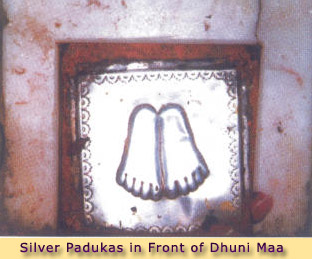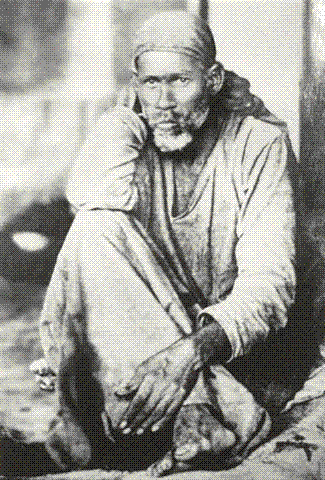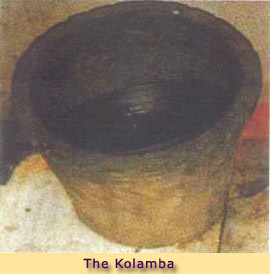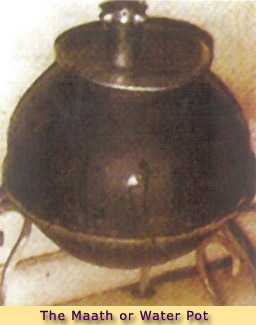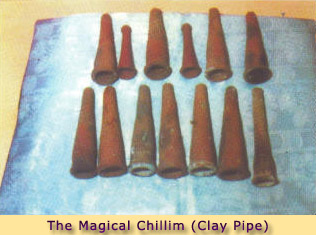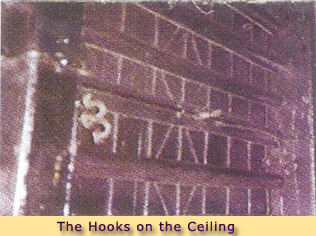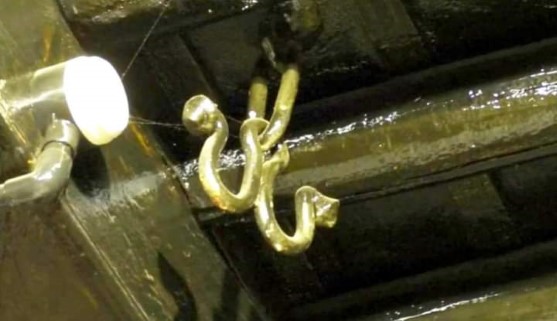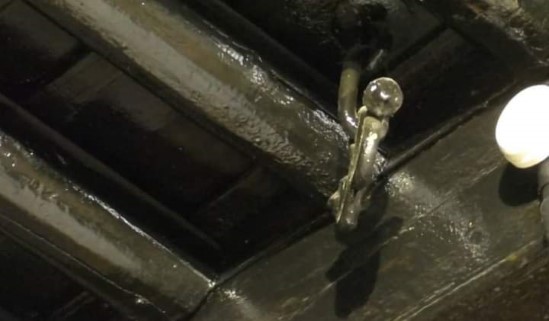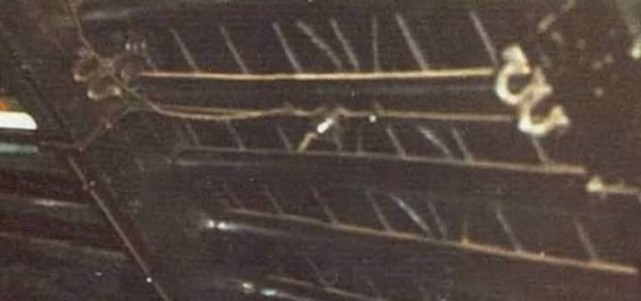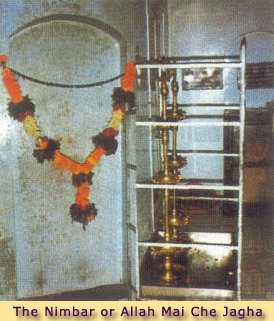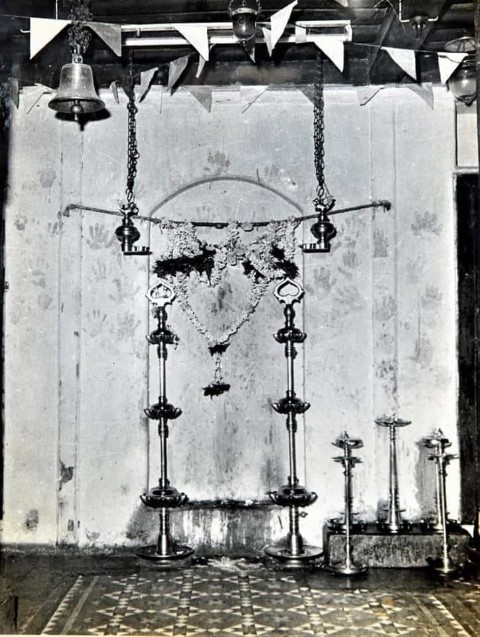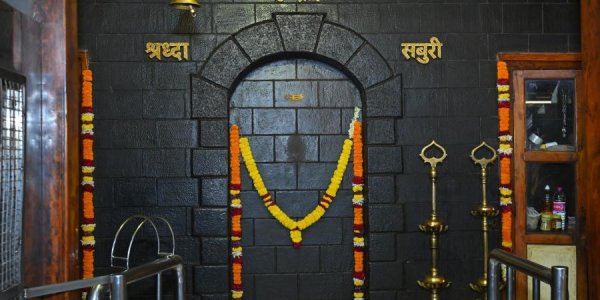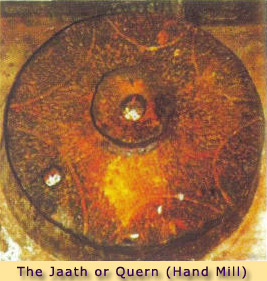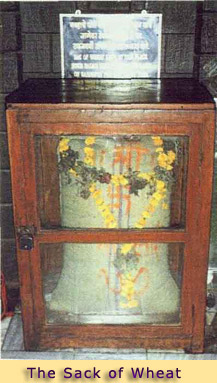DWARAKAMAI (MASJID) |
||
THE SMALL SILVER PADUKAS IN FRONT OF DHUNI MAA These small silver Padukas are in the North West corner, and in front of the Dhuni Maa. It is the sacred place where Baba sat every morning before 5.00 AM for about an hour. This hour Baba spent in solitude. At that time other devotees were not allowed to approach Baba, except for the Sevkaries who quietly came and swept the Dwarakamai. Bhagoji Shinde was the first devotee to go to Baba and massage his burnt hand.
THE PUJA PILLAR Baba sat near the pillar, which is adjacent to the small Silver Padukas. Baba always sat straight and did not rest his back against the pillar. Baba was very fond of the pillar and asked many devotees to perform Puja to it. The details are as follows: In the year 1908, Tatya Saheb Nulkar, who was a sub judge in Pandharpur came to stay in Shirdi. Baba asked him to stay in the Chavadi. One day, in the morning Baba told Shama, “Ask Mhatara (old man) to perform Puja to the pillar”. Shama went and told Nulkar (Mhatara) exactly what Baba had said. Both of them discussed the reason for this, but could not come up with an answer. At last they consulted the almanac, and found that it was Vyas Purnima or Guru Purnima. But Baba had asked him to perform puja to the pillar, and not to him. Nonetheless they were happy that at least he had allowed puja to be performed in the Dwaraka Mai. Nulkar was performing puja to the pillar when Shama turned up. Baba said, “Why is he performing puja all by himself? Why can’t you too perform the puja?”. Shama replied “I will not perform puja to this pillar. But if you will allow me to perform pooja to you, I will gladly do so. I will only worship you and not this or any other pillar”. After a lot of debate and discussion, Baba finally agreed. Dada Kelkar was aware that it was Guru Purnima, so he sent for Tatya who had gone to his farm. Both of them went with puja materials, and performed Guru Puja. The rest of the devotees present in Dwaraka Mai followed suite. They offered fruits, dakshina and vastra (dhotis) to their Guru. The dhoti was of no use to Baba but they got the opportunity to do Guru Puja that day and they hoped that it would continue in the future. Thus the festival of Guru Purnima started, and now it is celebrated as a three day function by the Sansthan. On the first day there is Akhand Parayan, the second day is the main festival and it concludes on the third day with Gopal Kaala. Guru Purnima is celebrated in the Ashada Masa (June-July). The meaning of “Baba Sitting in Front of Dhuni Maa” There is also an original photograph of Baba sitting in front of Dhuni Maa taken during Baba’s period.
This pose possibly represents the “inward journey” that we have to take to reach “Baba”, and be one with him. This journey started with the first step of withdrawing our Karmendriyaas totally from this mundane life. This is represented by the left leg which is not seen. Control the Jnanendriyaas, which are to act over the Karmendriyaas which is represented by the right leg over the left leg. This is achieved by following the messages heard or insight derived from this inward journey. This is represented by the closed fist of the right hand which is kept next to the ear. An invisible Antakarna Chatushtaya with adhimanas as support is represented by the right hand kept next to the right ear. The left hand over the right leg represents surrendering to him in totality. We have to surrender all of the following, the three Shariras, the trigunas, the arishadvargas, the 5 pranas, and the 5 koshas. This is achieved by following the Jnana Marga, Bhakti Marga, Karma Marga or the blend of these three. THE KOLAMBA This Kolamba is an earthen container which was used by Baba to mix the food received by Bhiksha. Baba used to take Biksha from five blessed houses daily. He called out "Oh. Lassie give me a piece of bread". He begged three to four times a day till noon, but His Biksha was erratic and irregular (Ref. ESS, Ch.VIII). This mixture known as Kala would then be distributed to numerous devotees, birds, cats and dogs and Baba did not drive them away. Baba himself ate very little of the remaining food. This practice of Biksha went on till His Mahasamadhi. If He could not go He deputed someone else like Vamanrao Patel or G.G. Narke.
The significance of the Kolamba lies in the fact that it is made of clay and thus may break at any time. Just as the human body is transient and death may strike at any moment the body also acts as a container to mix the various acts of life. These actions and their consequences are akin to the food got by begging from our own doings. The taste of the food may be sweet (happiness) or sour (sorrow). Baba by mixing the food is teaching us to receive the happenings in our lives with equanimity. The food will taste sweet, sour or bitter as long as it is in contact with the tongue. Once it crosses the tongue no taste is experienced, as there are no separate compartments in the digestive system. For the digestive system different types of food are the same for it to conduct its function. The tongue is the most important organ of our body. We do all kinds of deeds just to fill its needs not only for ourselves but for our generations to come. Everyone is busy trying to amass wealth, when we are not sure of our very own existence, thus becoming a slave to passions, thereby hiding the real “self”. Baba is teaching us not to become a slave of the tongue. Having the tongue under our control, we can march towards the supreme. The Pujari from Samadhi Mandir comes and offers Bhog to Baba twice a day, and leaves some Prasad in this Kolamba for the devotees to share. Various devotees offering Prasad to Baba offer it to Dhuni Maa and leave some in this Kolamba. THE MAATH OR WATER POT The Maath or Water Pot is an earthen pot in which Baba stored water. Baba himself used to carry water from the well behind the Samadhi Mandir and fill this pot. This Maath or Water Pot is placed on a stand made of coiled cloth next to the Kolamba adjacent to the southern wall of the Dwarakamai. The Maath or Water Pot kept in the Dwaraka Mai has been changed numerous times. However, the stand (coiled cloth) is in the museum. Devotees used the water as “Tirth” to get relief from their ailments. Now-a-days this pot is being filled by the Pujari of the Dwarakamai.
THE MAGICAL CHILLIM (CLAY PIPE) The Magical Chillim was Baba’s constant companion during his sojourn on earth. Blessed was the potter who made them, and blessed was the clay that touched Baba’s hands and lips. On the right side of the Maath or Water Pot in the corner were a stack of Chillims’ that Baba had smoked. And next to them in another heap were new and unused Chillims. Till the year 1930, the Chillims were kept this way. Now, the unused new Chillims are kept in the Museum in Dixit Wada. Chandbhai Patil was a truly blessed soul, who got the first taste of Baba’s Chillim. The bondage between them was great. Baba after smoking and sharing his Chillim actually went and stayed with Chandbhai. He was instrumental in brining Baba back to Shirdi, along with his marriage party.
Baba bestowed his grace on many a devotee by allowing them to smoke his Chillim. The most amazing story is of Balaram Dhurandar (Shri Sai Satcharitra, Chapter 51). He was troubled by bouts of cough and had asthma for six years. On his visit to Shirdi he went to the Dwaraka Mai one afternoon, and with great humility started pressing Baba’s feet. Baba handed him his Chillim to smoke. Balaram accepted it as Prasad, and took a puff. The very thought of smoking was painful and alien to him. He had utmost faith in Baba, so he smoked a while and humbly returned the Chillim to Baba. Lo! His asthma vanished and he was relieved of the tightness in his chest. He wasn’t tormented by breathlessness or coughing bouts thereafter. However, on the day that Baba took Mahasamadhi his asthma was triggered and he coughed all day. That day and only that day did he cough, and wasn’t bothered by it again. How could he ever forget the miracle of the clay pipe? Ganesh S Khaparde was a renowned, wealthy lawyer from Amaravati. He was a loyal aid of Lokamanya Tilak, who was serving a six-year sentence in Burma. Baba kept Khaparde in Shirdi and rescued him from the clutches of the British, who were waiting for a chance to prosecute him for treason and sedition. Khaparde was a spiritual man, well versed in Sanskrit, the Shastras and the Puranas. Time and again during the Arati Baba made mystic signs and offered his Chillim, when he could unravel the answers. At times the Chillim calmed his restless mind and gave him reassurance. On 22nd January 1912 Khaparde writes, “During the course of worship he (Baba) put two flowers in his nostrils, and two others between his ears and head. I thought this was his instruction, and when I interpreted it in my mind, he offered his Chillim to me and thus confirmed it”. Krishnaji Bhishma, the author of Sai Sagunopasana (Arati Book), was disgusted by the thought of devotees drinking Paad Tirth of a Muslim Sai Baba. He was horrified to see Brahmin devotees puff the Chillim after Baba had smoked it, and mentally he resolved not to do both. One day Baba narrated a story to him. It was the same dream vision that he had had earlier. While narrating the story Baba usually passed his Chillim to Bhishma. He took a puff and was thrown into bliss and ecstasy, and changed for life. At that moment, he became an ardent devotee. Bhagoji Shinde and Mahalsapati smoked the Chillim with Baba every morning. Now the Chillim is offered to Baba’s photograph in the Chavadi during Adkar’s Arati Sai Baba Soukhya Datara Jeeva. THE HOOKS ON THE CEILING These hooks are on the ceiling in front of the Nimbar. Nana Saheb Dengle brought a wooden plank of about 8” wide and 5' in length and gave it to Baba for sleeping. He thought that Baba could sleep on it instead of sleeping on the floor. Baba however tied this plank with old rags to the hooks on the ceiling like a swing. After lighting four Panthis (earthen lamps), He placed them in each corner of the plank. Baba The Yogi Raj' then slept on this plank. One could see him either sitting there with his head bent, or sleeping on the plank. Many people wondered how he got up and down from this plank, and tried to watch this leela, but were not successful. Then one day Baba broke the plank. This leela is described in detail in the Shri Sai Satcharitra Chapter 10.
Dasganu says, "The plank hung so close to the ceiling that no one could sit upright. One could only sit on it bending one's body like an arch. Yet this great Yogi slept on it"! (Refer Bhakta Leelamrita, Chapter 31). "Meditate always on My formless nature, which is knowledge incarnate, consciousness, and bliss. If you can not do this, meditate on My Form from top to toe, as you see here night and day " said Baba to Dhabolkar (Ref. ESS. Ch. XVII). Although Baba was surrounded by countless devotees, Shyama and Mahalsapathi being His constant companions, yet none of them saw Baba get up or get down the 'swing bed'. "You thought, that I was in Shirdi, with a body composed of the five elements and 3 1/2 cubics in length, and not outside of it. Now you see and determine for yourself whether the person you see here now, is the same you saw at Shirdi” said Baba to Mankar at Machindragada (Satara district) (Ref. ESS, CH. XXXI). "I require no door to enter, I have no form or any extension, I live everywhere, I carry on as the wirepuller, alter the actions of the men who trust Me and merge in Me" said Baba to Megha. Baba is Parabrahma. One who is without birth, body, age and death. He was, is and will be with us eternally. When that being the case, how could they see Him in the “Anima or the formless state?” Devotees who visit Dwaraka Mai today look with wonderment at the ceiling in front of the "Nimbar" at these hooks. THE NIMBAR OR ALLAH MIA CHE JAGHA Upon ascending the central steps (3 steps) of the Dwarakamai Sanctum Sanctorum, the Nimbar is directly in front. The Nimbar or Allah Mia Che Jagha (the place of Allah Mia) is the arched structure in the wall. It is in the western wall of the Dwarakamai next to the ever burning lamps. It is garlanded daily, and often is venerated with a shawl. In a Masjid the Nimbar is said to represent the Darga of Mecca. The devout Muslims do Namaz in front of it. Mention is made of this Nimbar in several places in the Shri Sai Satcharitra. The Urs started in 1897 and during that yatra (fair), the “Sandal Procession” also took place. This procession is held in honor of great Muslim saints. Chandan paste and scrapings are put in a Thali and carried around the village in procession. After returning to the Masjid the chandan is pasted with the hands on this Nimbar. This Sandal procession was started by Amir Shakkar Dalal of Korhla. Now the descendants of Abdul Baba carry on this tradition. (Refer Shri Sai Satchritra Chapter 6).
Old Picture of Nimbar (Photo Courtesy: Shri.Nandakumar Revannath Deshpande Nimonkar) After the Noon Arati the devotees went home. Baba then went inside, and sat behind the curtain, with His back to this Nimbar for his meal. There were two rows of devotees one on each side. After all the Naivedya was mixed together (kaala) and placed before Baba, he consecrated it and offered it to god and everybody dined to their hearts' content. (Refer Shri Sai Satcharitra Chapter 38). Devotees can see "Shraddha" and "Saburi" name plates in Gold are placed on either side of the Nimbar. Later, in the year 2025. To be exact, "OM SAI" name plate was installed on the Nimbar above the words "Shraddha" and "Saburi" on 12th May 2025.
THE EVER BURNING LAMPSBaba was very fond of lighted Divas (earthen lamps). From the beginning of His stay in the Dwarakamai, Baba lit divas daily. And they burned perpetually. Baba celebrated Diwali with numerous lamps. He tore thin strips of cloth and twisted them and used them as wicks. Often He tore His old Kafni into thin strips and used it as wicks. In Shri Sai Satcharitra Chapter 5, the leela of his lighting the lamps with water is given. One day the grocers refused to give him oil. Unperturbed He returned to the Dwarakamai. He took the empty tumbler that had a smidgen of oil in it. He filled it with water and drank it. Consecrated water and a few drops of oil and offered it to God, and then lit the lamps. Lo! They burned throughout the night. The Jyoth has been burning perpetually since then. When the brass lamps are cleaned the wicks are temporarily placed in another lamp. The oil dripping from these lamps have healing properties. Numerous devotees have used it for Arthritis, Migraine, and other ailments with wonderful results. THE JAATH OR QUERN (HAND MILL) In the Shri Sai Satchritra, Chapter 1 the wonderful leela of Baba grinding the wheat is described. During the year 1910, One day in the early morning, Baba sat down at the Quern to grind wheat. Four village women saw this; they took the peg of the quern from his hand and started grinding the wheat. While doing this they thought “Baba has no kith or kin and subsists on Bhiksha. So he will give us the flour”. After all the wheat was ground, they divided the wheat into four portions for themselves. Baba then used very foul and abusive language. He said, “Phukat Khau Randa” (free looting prostitute) and told them to take the flour and throw it on the village boundary. At that time, Cholera was raging through out the village. Seven people had already succumbed to the epidemic. This was Baba’s remedy to stop the epidemic. Since then, Cholera has not occurred in Shirdi, although neighboring villages are often afflicted. What was the relationship between Cholera and wheat flour?
Cholera is called Mahamaari or the great killer. Mahamaari means sure death every time it strikes. There is no greater fear than the fear of death. Birth is followed by death at sometime for sure. One who has conquered the fear of death is immortal. So if one wants to conquer the cycle of birth and death, then one has to be liberated and free. If the ultimate goal is liberation then why is one bound? The fact is that human beings are bound by Karma (actions) and Maya. In fact karma and maya are inseparably interlinked. They are the two facets of life. The significance of Quern or Hand Mill Baba lived in Shirdi for 60 years and he ground the mental, physical afflictions and the miseries of innumerable devotees. In the Quern, lower stone represents Karma and upper stone represents Bhakti, and the handle of the Quern represents Jnana (knowledge) or self realization. Self realization is not possible unless there is the prior act of grinding of all our impulses, desires, sins, trigunas and ego. Besides the philosophical significance and grinding the cholera germs Baba daily ground sins, mental and physical afflictions and miseries of his innumerable devotees and he is still continuing to do so. Once Kabir saw a woman grinding corn and said, “I am weeping because I feel the agony of being crushed in this wheel of worldly existence, like the corn”. His guru Nipathiranjana reassured him saying, “Do not be afraid, but hold tightly the handle of knowledge of the hand mill, and do not wander far away. Turn inward to the centre and you are sure to be saved”. (Refer Shri Sai Satcharitra, Chapter 1) Devotees can see this hand mill in the Dwarakamai entreating Baba to grind their sins. Another hand mill which Baba used for cooking is kept in the Museum. THE SACK OF WHEATDuring Baba’s sojourn in Shirdi, this sack of wheat was kept resting against the wall of the Dwarakamai. Now this sack of wheat is kept in a glass small cupboard, with a glass door next to the hand mill. Balaji Patil Nevaskar rendered selfless seva to Baba, by sweeping and cleaning the streets daily that Baba trod on.
Every year when there was a harvest in his field he would bring the whole quantity of wheat to Baba and maintain his family on whatever Baba gave him. Whether the amount of wheat was large or small did not matter to him as he believed that it belonged to Baba. Baba used to eat Chapattis made out of this wheat. (Refer Shri Sai Satcharitra, Chapter 35). This practice continued till he died. After him, his son also continued the same tradition. The wheat bag used to be replaced on every Ramanavami day by his family. Now the Sansthan has continued the tradition and will replace the old wheat bag with the new one. The old wheat bag is sent to Saibaba Prasadalaya. |
||
(Courtesy: Ambrosia in Shirdi and Baba’s Gurukul by Vinny Chitluri). |
||
© 2011 Saiamrithadhara.com. All Rights Reserved. |
